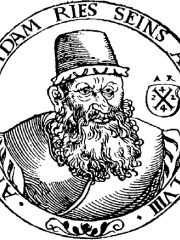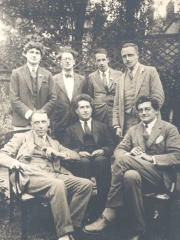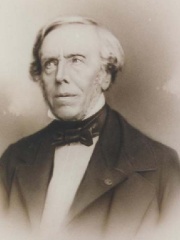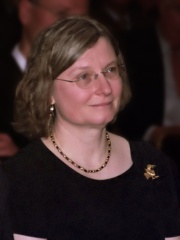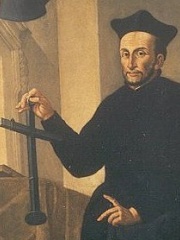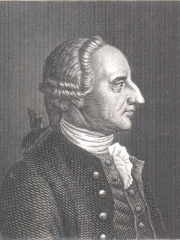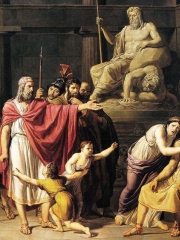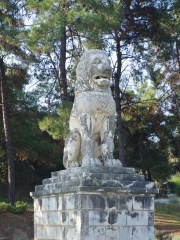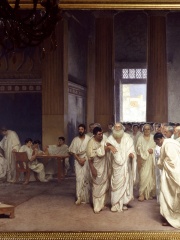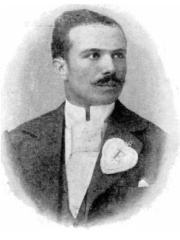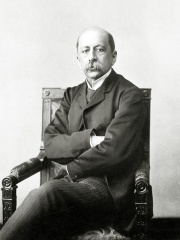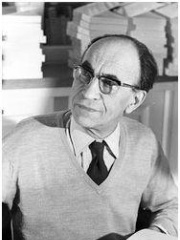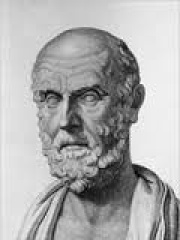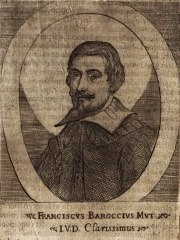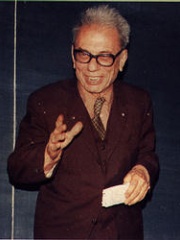MATHEMATICIAN
Geminus

 Geminus
Geminus
Geminus of Rhodes (Greek: Γεμῖνος ὁ Ῥόδιος), was a Greek astronomer and mathematician, who flourished in the 1st century BC. An astronomy work of his, the Introduction to the Phenomena, still survives; it was intended as an introductory astronomy book for students. He also wrote a work on mathematics, of which only fragments quoted by later authors survive. Read more on Wikipedia
His biography is available in 23 different languages on Wikipedia. Geminus is the 550th most popular mathematician (down from 501st in 2024), the 580th most popular biography from Greece (down from 569th in 2019) and the 7th most popular Greek Mathematician.
Memorability Metrics
Page views of Geminus by language
Among MATHEMATICIANS
Among mathematicians, Geminus ranks 550 out of 1,004. Before him are Theodosius of Bithynia, Adam Ries, Andrew M. Gleason, Ibrahim ibn Sinan, Edward Arthur Milne, and Ronald Graham. After him are William Whiston, Jean-Baptiste-Charles-Joseph Bélanger, Ingrid Daubechies, Al-Nayrizi, Johann Baptist Cysat, and Abraham Gotthelf Kästner.
Most Popular Mathematicians in Wikipedia
Go to all RankingsTheodosius of Bithynia
160 BC - 100 BC
HPI: 59.91
Rank: 544
Adam Ries
1492 - 1559
HPI: 59.82
Rank: 545
Andrew M. Gleason
1921 - 2008
HPI: 59.81
Rank: 546
Ibrahim ibn Sinan
908 - 946
HPI: 59.81
Rank: 547
Edward Arthur Milne
1896 - 1950
HPI: 59.78
Rank: 548
Ronald Graham
1935 - 2020
HPI: 59.78
Rank: 549
Geminus
HPI: 59.75
Rank: 550
William Whiston
1667 - 1752
HPI: 59.74
Rank: 551
Jean-Baptiste-Charles-Joseph Bélanger
1790 - 1874
HPI: 59.72
Rank: 552
Ingrid Daubechies
1954 - Present
HPI: 59.71
Rank: 553
Al-Nayrizi
865 - 922
HPI: 59.70
Rank: 554
Johann Baptist Cysat
1585 - 1657
HPI: 59.70
Rank: 555
Abraham Gotthelf Kästner
1719 - 1800
HPI: 59.69
Rank: 556
In Greece
Among people born in Greece, Geminus ranks 580 out of 1,024. Before him are Philostratus of Lemnos (200), Cleombrotus II (-250), Laomedon of Mytilene (-400), Cineas (-400), Thrasymedes (null), and Ioannis Mitropoulos (1874). After him are Agesipolis II (-400), Charilaos Trikoupis (1832), Louis Dumont (1911), Marinella (1938), Machanidas (-254), and Apollodorus the Epicurean (-150).
Others born in Greece
Go to all RankingsPhilostratus of Lemnos
WRITER
200 - 230
HPI: 59.82
Rank: 574
Cleombrotus II
POLITICIAN
250 BC - 300 BC
HPI: 59.82
Rank: 575
Laomedon of Mytilene
MILITARY PERSONNEL
400 BC - 360 BC
HPI: 59.81
Rank: 576
Cineas
PHILOSOPHER
400 BC - 300 BC
HPI: 59.80
Rank: 577
Thrasymedes
POLITICIAN
HPI: 59.78
Rank: 578
Ioannis Mitropoulos
GYMNAST
1874 - 2000
HPI: 59.77
Rank: 579
Geminus
MATHEMATICIAN
HPI: 59.75
Rank: 580
Agesipolis II
POLITICIAN
400 BC - 370 BC
HPI: 59.75
Rank: 581
Charilaos Trikoupis
POLITICIAN
1832 - 1896
HPI: 59.75
Rank: 582
Louis Dumont
ANTHROPOLOGIST
1911 - 1998
HPI: 59.73
Rank: 583
Marinella
SINGER
1938 - Present
HPI: 59.72
Rank: 584
Machanidas
POLITICIAN
254 BC - 207 BC
HPI: 59.71
Rank: 585
Apollodorus the Epicurean
PHILOSOPHER
150 BC - 150 BC
HPI: 59.70
Rank: 586
Among MATHEMATICIANS In Greece
Among mathematicians born in Greece, Geminus ranks 7. Before him are Hippocrates of Chios (-470), Meton of Athens (-500), Conon of Samos (-280), Theaetetus (-417), Aristyllus (-400), and Diocles (-240). After him are Francesco Barozzi (1537), Dinostratus (-390), Cahit Arf (1910), and Demetrios Christodoulou (1951).
Hippocrates of Chios
470 BC - 410 BC
HPI: 70.74
Rank: 1
Meton of Athens
500 BC - 460 BC
HPI: 69.92
Rank: 2
Conon of Samos
280 BC - 221 BC
HPI: 67.38
Rank: 3
Theaetetus
417 BC - 369 BC
HPI: 66.49
Rank: 4
Aristyllus
400 BC - 300 BC
HPI: 65.94
Rank: 5
Diocles
240 BC - 180 BC
HPI: 61.66
Rank: 6
Geminus
HPI: 59.75
Rank: 7
Francesco Barozzi
1537 - 1604
HPI: 59.21
Rank: 8
Dinostratus
390 BC - 320 BC
HPI: 58.29
Rank: 9
Cahit Arf
1910 - 1997
HPI: 58.27
Rank: 10
Demetrios Christodoulou
1951 - Present
HPI: 55.17
Rank: 11

